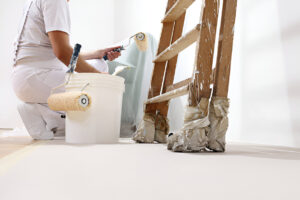Embarking on a house painting project can rejuvenate your living space, adding vibrancy and freshness to your home. However, a successful painting endeavor requires more than just a brush and a bucket of paint. In this guide, we’ll explore three key aspects crucial for achieving a flawless finish: proper preparation, selecting the right paint and tools, and mastering execution and technique. Additionally, we’ll delve into post-painting care and maintenance to ensure the longevity of your newly painted surfaces. By following these tips, you’ll not only enhance the aesthetic appeal of your home but also ensure a durable and high-quality finish that withstands the test of time.
Mastering the Art of House Painting
Embarking on a house painting project is akin to wielding a brush as an artist does a paintbrush on a canvas, each stroke a deliberate expression of creativity and care. Mastering the art of house painting goes beyond mere application; it entails understanding the nuances of color, texture, and technique to transform a space into a masterpiece of design and ambiance. In this section, we delve into the intricacies of house painting, exploring the craftsmanship required to achieve flawless finishes, the choices that influence the aesthetic impact of your home, and the methods that ensure longevity and durability. Whether you’re a seasoned DIY enthusiast or a homeowner seeking professional insight, join us on this journey as we uncover the secrets to mastering the art of house painting.
Proper Preparation
Before diving into painting, thorough preparation is essential. Start by cleaning the surfaces to be painted and removing any dirt, grease, or mildew. Repair any cracks or holes in the walls and sand rough areas to ensure a smooth finish. Mask off areas you don’t want to paint, such as trim or windows, using painter’s tape. Lastly, prime the surfaces to promote adhesion and create an even base for the paint to adhere to. Proper preparation sets the stage for a successful painting project and ensures a professional-looking result.
Selecting the Right Paint and Tools
Choosing the right paint and tools can significantly impact the outcome of your project. Opt for a high-quality paint that suits the surface you’re painting and the desired finish. Consider factors such as sheen, durability, and ease of application. Additionally, invest in quality brushes, rollers, and other painting tools to achieve smooth and even coverage. Don’t forget to check whether any specialized tools are required for your specific project, such as a paint sprayer for large areas or intricate trim work. By using the right paint and tools, you’ll streamline the painting process and achieve superior results.
Execution and Technique
When it comes to painting, the technique is key. Start by cutting in around the edges and trim with a brush before using a roller for larger areas. Work in small sections, maintaining a wet edge to avoid visible lap marks. Use long, even strokes and apply multiple thin coats rather than one thick coat to prevent drips and ensure proper coverage. Pay attention to drying times and environmental conditions, as they can affect the paint’s performance. Lastly, step back periodically to assess your progress and make any necessary adjustments. Mastering proper painting techniques is essential for achieving a professional-looking finish.
Post-Painting Care and Maintenance
Once the paint has dried, it’s important to take steps to preserve and maintain your newly painted surfaces. Remove painter’s tape carefully to avoid peeling off any paint. Clean up any spills or splatters promptly with soap and water. Keep an eye out for any signs of wear or damage, such as chips or stains, and touch up as needed to keep your walls looking fresh. Additionally, consider implementing a regular cleaning routine to remove dust and debris and prevent buildup over time. By taking proactive measures, you can extend the life of your paint job and keep your home looking its best for years to come.



